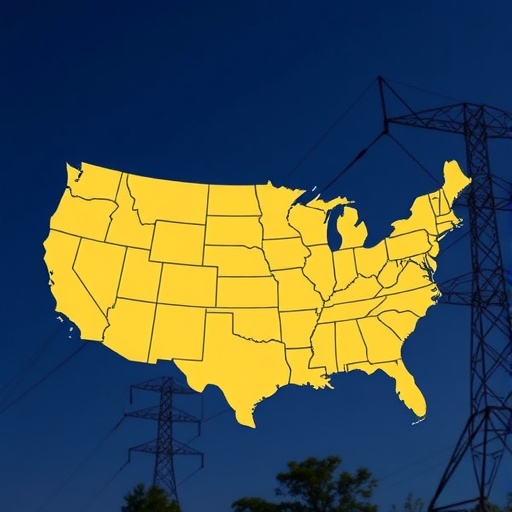In the evolving landscape of energy markets, the value of electric transmission infrastructure plays a pivotal role in determining the efficiency, reliability, and economic viability of power systems. Recent research published in Nature Communications by Kemp, Millstein, Gorman, and colleagues has shed new light on the intricate dynamics governing transmission value within United States power markets. This study offers a deeply technical and comprehensive analysis, unraveling the factors driving transmission’s worth and its critical influence on market behavior, policy decisions, and energy transition strategies.
Electric transmission lines form the backbone of the electrical grid, enabling the movement of electricity from generation sites—often located far from demand centers—to consumers. Their valuation is not merely an economic metric but embodies a complex interplay of market rules, generation mix, demand patterns, and regulatory frameworks. The paper underscores that, unlike traditional assets, the value of transmission is highly context-dependent, fluctuating with operational contingencies and policy-induced transformations.
At the core of the research is a novel framework that dissects transmission value into constituent drivers, leveraging large-scale market simulations and advanced optimization algorithms. The authors deploy a detailed representation of fifty U.S. power markets, aligning operational data with market outcomes to extract granular insights. Notably, the framework integrates considerations of congestion patterns, locational marginal pricing, and temporal demand variability, which collectively dictate congestion costs and the economic rationale for transmission investments.
One of the groundbreaking findings pertains to how renewable energy integration reshapes transmission value. As solar and wind generation capacities expand, they introduce spatial and temporal variability in power flows, altering congestion hotspots and thus affecting transmission’s marginal worth. The study meticulously quantifies these shifts, revealing that certain transmission corridors see amplified value due to their role in facilitating renewable energy delivery while others experience reduced importance as generation disperses.
Moreover, the authors emphasize the significance of flexibility resources, such as energy storage and demand response, in modulating transmission value. By alleviating peak congestion and shifting loads, these resources contribute to flattening price gradients across the network, subsequently diminishing the premium assigned to transmission expansions. This interdependence highlights the need for integrated planning approaches that jointly consider grid infrastructure and distributed energy resources.
Technological innovation emerges as another critical factor impacting transmission valuation. The paper explores advancements in grid management tools, including enhanced grid monitoring, dynamic line rating, and power flow control devices. These innovations optimize existing assets’ utilization, effectively increasing their value without necessitating costly physical expansions. The research suggests that policy frameworks should incentivize the deployment of such technologies as an alternative or complement to transmission buildouts.
The role of market design reforms also features prominently in the study. Current market rules may inadequately capture the true economic benefits of transmission, especially under high-renewable scenarios. Kemp et al. illustrate how modifications to pricing mechanisms, such as incorporating scarcity pricing or transmission rights adjustments, can more accurately reflect congestion costs and better signal investment needs. These reforms are critical for ensuring transmission investments align with system-wide cost reductions rather than isolated benefit zones.
Importantly, the paper rigorously addresses the uncertainties inherent in transmission valuation, stemming from factors like fuel price volatility, regulatory shifts, and technology costs. Employing scenario analysis and sensitivity testing, the authors provide policymakers with a robust toolset to navigate these uncertainties. Such risk-aware assessments support more resilient investment strategies, mitigating the risk of stranded assets or underinvestment.
The research also tackles the distributional consequences of transmission value. The geographic concentration of benefits and costs can influence regional equity and acceptance of infrastructure projects. Through comprehensive mapping of value flows and beneficiary identification, the study elucidates the socio-economic implications of transmission planning, urging inclusive stakeholder engagement to ensure equitable outcomes.
Kemp and colleagues do not neglect environmental considerations. By facilitating a cleaner energy mix and reducing curtailments of renewables, valuable transmission assets contribute to substantial emissions reductions. The integration of environmental metrics into the valuation process presents a multidimensional perspective, balancing economic efficiency with sustainability goals.
Underlying this comprehensive analysis is extensive data assimilation, blending historical market operations, projected demand scenarios, and generation portfolios. Such integrative data modeling lends credibility and precision to the findings, reinforcing their applicability in real-world decision-making. The granularity achieved surpasses prior studies by capturing sub-hourly dynamics and finer spatial resolution, crucial for modern grid complexities.
The implications of this work reach far beyond academic discourse. Utility planners, regulators, and market designers stand to benefit from a more nuanced understanding of transmission value drivers. By aligning investments with these insights, the power sector can accelerate its transition to a decarbonized, resilient, and economically efficient grid infrastructure capable of accommodating the rapidly evolving energy landscape.
The article further challenges conventional wisdom by revealing counterintuitive outcomes, such as scenarios where expanding transmission capacity yields diminishing returns due to emergent grid constraints. This nuanced perspective compels stakeholders to reconsider linear assumptions about infrastructure investments, advocating instead for adaptive, data-informed strategies responsive to system-wide feedback.
In conclusion, this landmark study by Kemp et al. represents a critical advancement in electric power systems research, offering a detailed, data-rich exposition of the underpinnings of transmission value. It equips decision makers with the analytical tools necessary to optimize grid investments amidst profound technological, economic, and environmental transformations. As the U.S. power system continues its evolution, insights from this work will be instrumental in crafting policies and investments that drive efficient, equitable and sustainable energy futures.
Subject of Research: Electric transmission value and its drivers in United States power markets
Article Title: Electric transmission value and its drivers in United States power markets
Article References:
Kemp, J.M., Millstein, D., Gorman, W. et al. Electric transmission value and its drivers in United States power markets.
Nat Commun 16, 8055 (2025). https://doi.org/10.1038/s41467-025-63143-5
Image Credits: AI Generated




